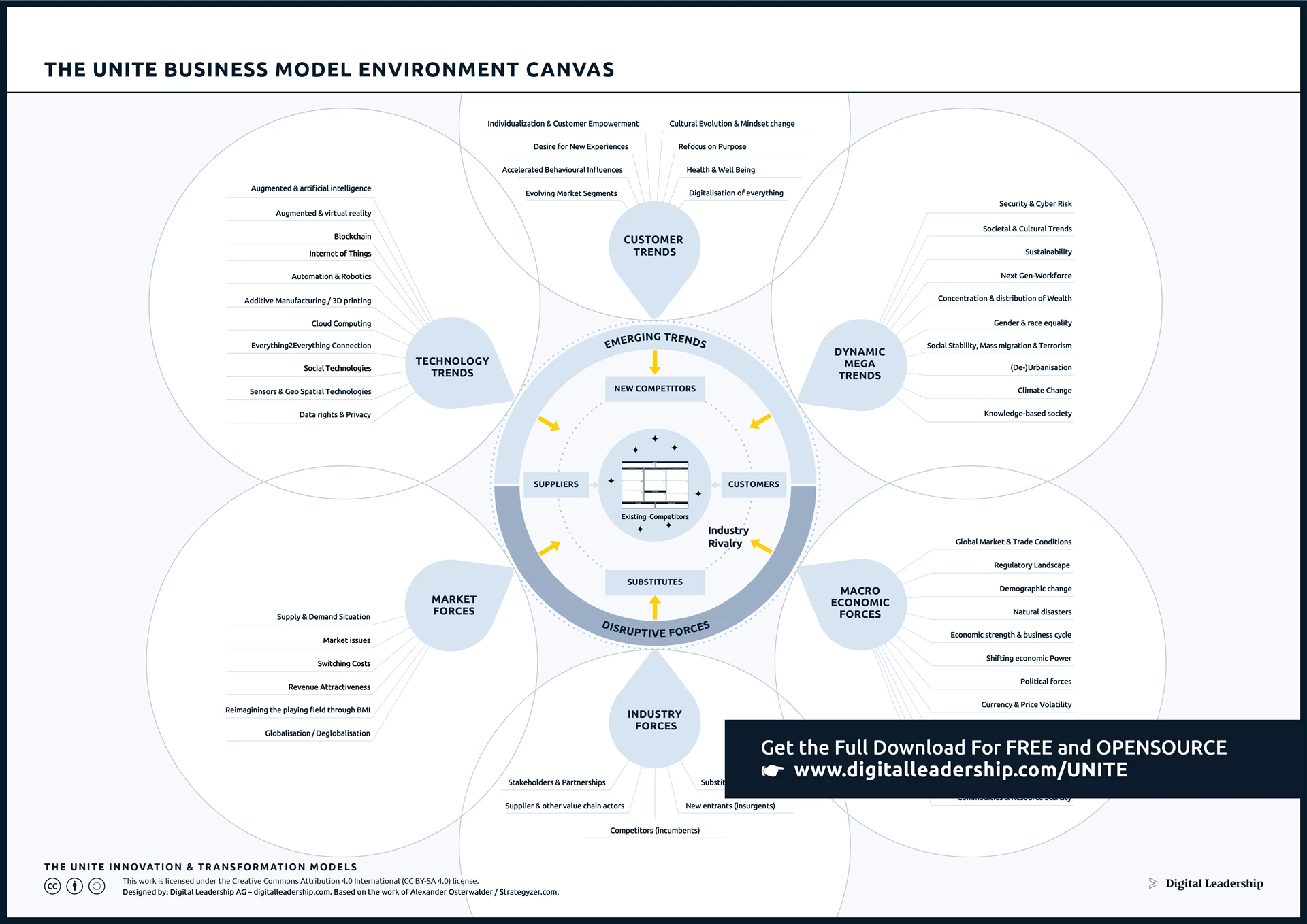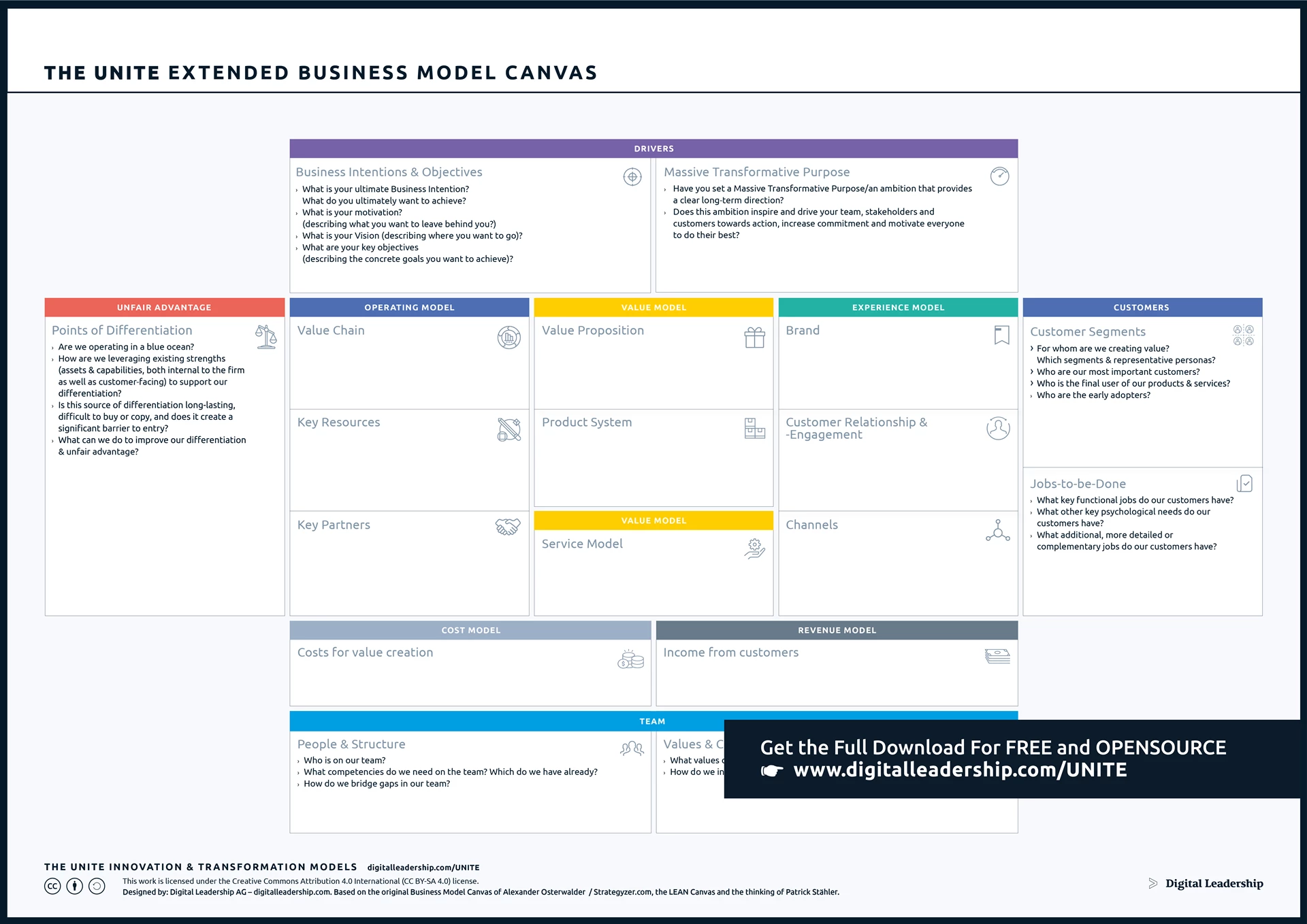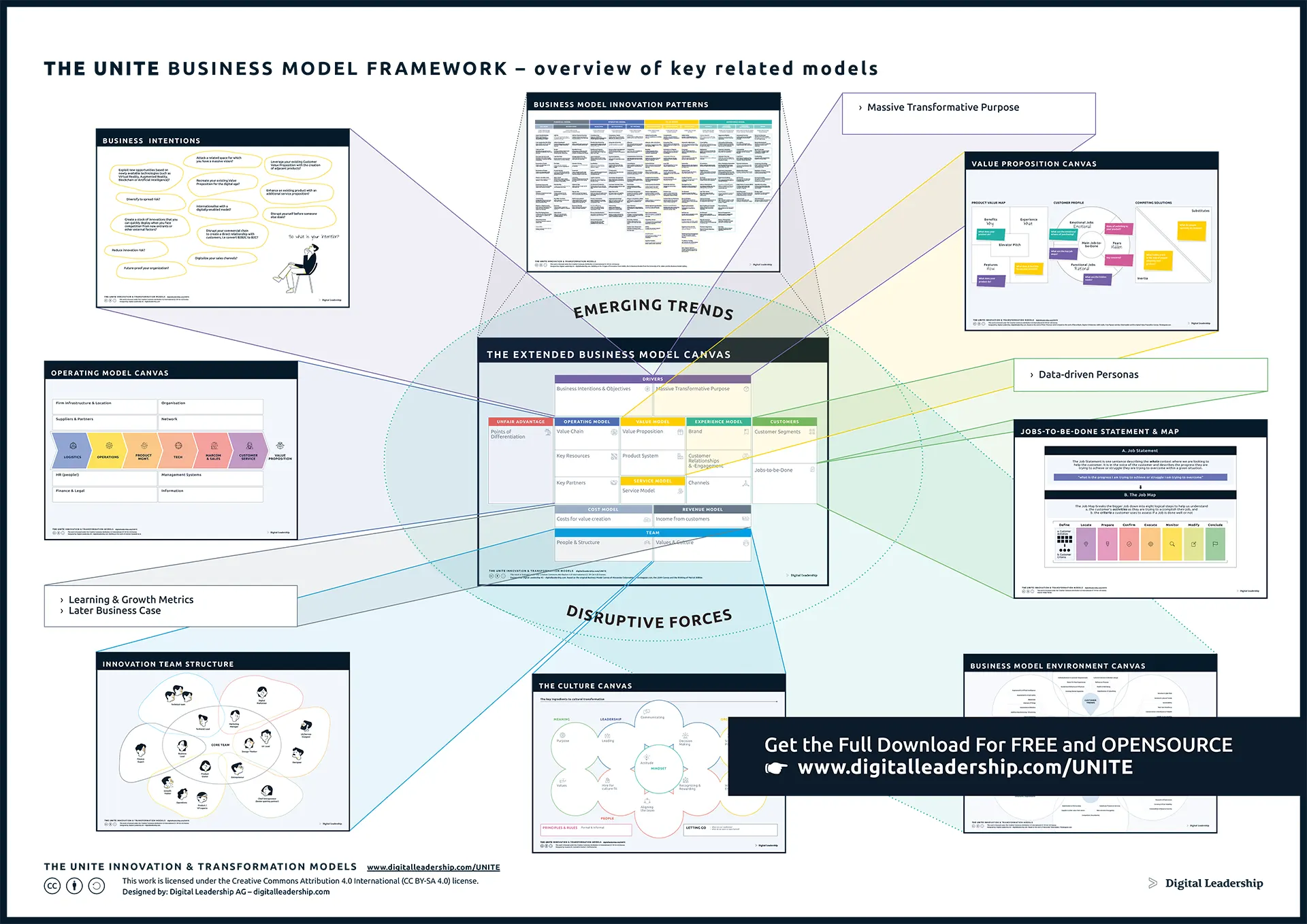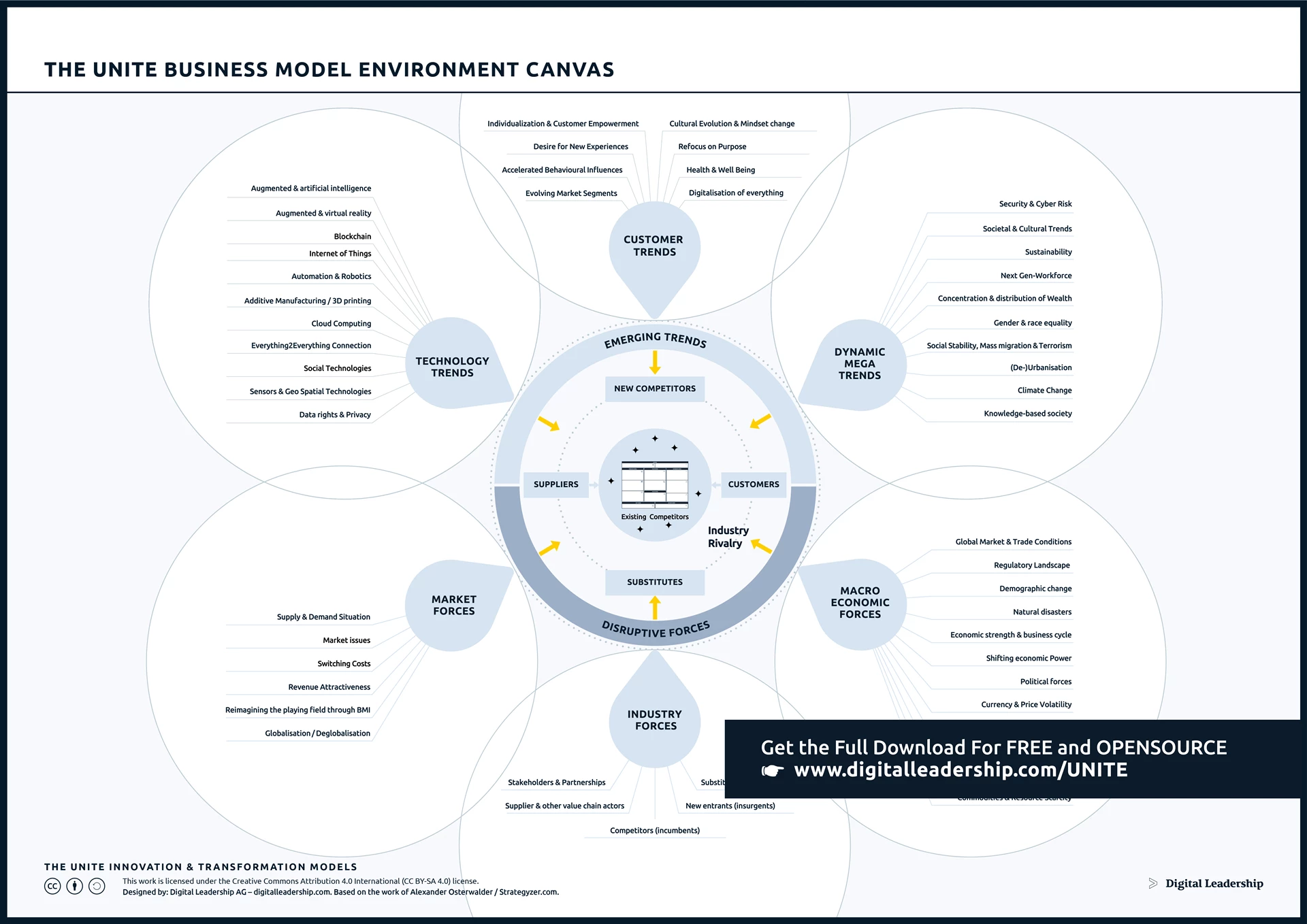Table of Contents
You don’t create Value Propositions or Business Models in a vacuum. You design, test, build and manage them in a particular context. The Business Model Environment Canvas helps you understand that context as the basis for (re)assessing your strategic choices.
What is the UNITE Business Model Environment Canvas?

Designed by: Digital Leadership AG – Based on the work of Alexander Osterwalder
Download the Complete Business Model Environment Canvas Package, including instructions for putting it to work for you today.
The Business Model Environment Canvas is organized into several layers. In the very center is your own Business Model. Then, your business is surrounded by its immediate, existing competitors, which is the zone of competitive rivalry. Building on Porter’s Five Forces, industry rivalry is based on changes in customer demand, the bargaining power of buyers, the threat of substitute products, the bargaining power of suppliers, and the threat of new entrants. The entire industry landscape is then influenced by emerging trends and disruptive forces. Unlike the Business Model itself, over which you have full control, external forces represent design constraints that you have to work with, and unfortunately, they are a moving target.
Working with the canvas is simple: basically, you get to play the What-If game. Simply go through the areas of each layer and ask yourself the tough questions. For example, “How is an aging population affecting us?” Or with regards to regulatory trends, “What will change when new rules or legislation come into effect?”
While you have some ability to impact your business’s internal environment, there are even environmental factors there that you can’t affect. Your teams will be affected by social relations, political conditions, and many government policies that influence their effectiveness at work.
Understanding the design constraints on your Business Model is becoming even more important as the rate of change accelerates. Just think about how the barrage of real-time information at our fingertips impacts and shapes our thoughts and views. If we don’t have a strong sense of the ways that our context is changing, we will not be able to anticipate and adapt fast enough to keep our business afloat.
For an old-school businessman, any disruption can cause fear, but changes in the business environment are more like an opportunity for an entrepreneur. You should exercise the foresight to play on the front foot and take the lead in your market. For that, there has to be a transforming technique and a strategic response to deal with disruptions and forces, large and small. The UNITE Business Model Environment Canvas is all about evaluating and shifting to meet these changing external factors head-on.
Business Model Environment Canvas is one of the most robust and reliable ways to analyze the extent to which the current domain of your business influence is tough and competitive. Considering the recorded retrospective patterns and the upcoming trends, any business using Business Model Environment Canvas could infer the level of their strength and position in the market. This eventually helps them to craft the best possible solution or most feasible strategy to avoid any possible loss or get maximum gain through any competitive advantage.
The Importance of the Business Environment
Being a budding entrepreneur, you might have control over things like value chains, operations, costings, and revenue, but there are countless external factors over which you have marginal to no control at all.
These all are external environmental factors. They exist outside of your company but indirectly impact internal matters and operations. These factors are real challenges to the current processes. A responsible leader is always accountable for identifying all these changes and working out a strategy to keep up with the pace of competition.
Choosing to identify and analyze the dynamic nature of these factors will allow you to protect yourself from uninvited and unexpected changes.
What is Your Business Environment?
When someone begins discussing “Business Environment” with you, what do they mean? What exactly is a business environment?
When we think about the outside influences acting on our business, we are thinking about its environment. It’s not very different from the environment in which we live; our daily decisions are based on a number of factors. (Do I need an umbrella? What sounds good for lunch? Which candidate should I support? Am I ready to go on a date?)
To make considerations about the environment easier, you can divide it into distinct sections. Business success is often determined by how well we adjust to changing environmental factors.
Economic Business Environment
What is the current state of the economy? What are the world’s broader economic conditions? Are people investing? How are interest rates influencing people? What is the current consumer sentiment? Do news stories predict economic growth?)
Of all the factors that affect business environments, the overall economic environment might be the most powerful. Additionally, businesses may have to battle against the perception that new trends should be influencing consumer decisions–even if they shouldn’t be.
Related: Creative Destruction Economics Definition & Examples
Social Business Environment
What are the public’s concerns? What messages do you want to send to potential customers? What attitudes or beliefs impact your business? How are demographic factors shifting?
The social factors that affect our business can be a unique challenge. As more consumers expect the businesses they frequent to exercise social concerns they share, more and more, we’re faced with deciding what role our business should play in the socio-cultural environment as a whole.
Political Business Environment
What role should your business be taking in responding to public policy? How would a change in leadership affect what you do?
The political environment is very much like the social environment. While we usually think of the overall business environment as being something external to our operations, both political and social factors can have a tremendous effect on a company’s internal environment.
How are you managing the potentially divergent political views held by members of your team?
Legal Business Environment
How do changing laws or regulations have a direct bearing on your business? Which regulatory agencies impact what you do?
Companies of any real size must employ someone appropriately connected to the internal and external rules your business must follow. The risks of getting the legal aspects of your business wrong are too great to ignore.
Technological Business Environment
Which technological developments require your attention? Is there technology your customers expect you to use?
The technological factors that exert influence on your business environment must be monitored carefully. The history books are littered with businesses that failed to adjust to developments in technology, and whole chapters are written about businesses that properly responded to such factors.
Segmenting the overall environment this way makes it easier to get a more complete understanding of your Business Environment, and that’s important because your observations can direct decisions. Business takes place in a dynamic environment; when we sit still, we’re often passed.
Determining Business Opportunities and Threats
As a business analyzes the business environment, the first round of research should be carried out—both internal to the company and the operating context (particularly focus on the identified assets and capabilities!) and the external context, including relevant industry sector news, as well as potential opportunities and threats.
You may find it’s best to focus your research on some key points.
Related: Identifying Hidden Market Opportunities for Innovation through JTBD
The External Business Environment
So many potential influences are beyond our reach: trade barriers, natural disasters, environmental factors, global trade patterns, special interest groups exerting power on public policy, and political factors.
These elements are almost completely beyond your company’s control.
Whether these shifts in the business environment become threats or opportunities will depend on your agility. Consider the COVID-19 pandemic, for example. The virus shuttered many businesses, while others wouldn’t even exist if their owners hadn’t pivoted when faced with challenges.
Physical resources
Some of the scariest investments decision-makers consider involve physical resources. The “stuff” of your business.
There are so many different factors that impact our work that it can be easy to ignore the materials, spaces, and tools that make our work possible.
Do your people have everything they need to be successful?
Human resources
Is your corporate culture open to innovation? Do you have an organizational structure that encourages risk-taking? Do you manage your human resources, or see its requirements a burden?
Building an innovation-focused business environment helps ensure that you’re properly positioned to move forward when the market demands it. Institute hiring practices that seek to bring in a diverse set of skills and experiences. Not all of the factors that make a potential hire desirable are easily quantifiable by a resume keyword search.
How are you addressing the continued development of the human pieces of your business? Does the training you offer have clearly stated, useful learning outcomes?
Is your selection process finding people who contribute to a dynamic business environment?
Related: The UNITE Culture Canvas – Identifying Organizational Culture Critical Elements
Industry Rivalry
Relationships with competitors can affect business operations in a variety of ways. As you consider your business environment, take into account the various rivalries that might impact your internal and external environment.
1. Competition in the industry
You should already know the major players in your sector. Monitor their innovations and how they adjust to changes in the business environment.
2. Potential of new entrants into the industry
We often get a warning when someone new is about to enter an industry. Be sure you’re a member of leading industry organizations and a reader of trade publications. These often break news about potential threats.
3. Power of suppliers
When more suppliers enter a market, your power increases. Materials and services may open for negotiation. Look for ways to minimize your costs.
Related: The UNITE Operating Model Canvas: Bridging the Strategy-Execution Gap
4. Power of customers
Conversely, as more rivals enter a sector, customers see their power increase. Options give customers leverage. Consider what makes what you offer more appealing than your competitors’ offers. What can you do to stand out in the crowd?
5. Threat of substitute products
Technological Factors that affect business operations often include new products that compete with what we offer. Be prepared to adapt to these developments, and adopt new technology where and when it’s appropriate.
Business Environment External Forces
All decision-makers need to be aware of the shifting realities that can affect their business interests. In fact, managing the internal and external factors that impact business operations is one of a business leader’s primary roles.
Innovation is not only vital for surviving but thriving. In the fast-paced ecosystem of the market, where many business giants struggle to sustain a reputable place, the external forces will be doing their best to affect your business in a negative way.
To help conceptualize the various forces that might influence business decisions, you can think of them in terms of Emerging Trends and Disruptive Forces.
Emerging Trends
Emerging Trends are shifts in consumer interest and manufacturing ability that are identifiable if you’re looking in the right places. While it’s impossible to predict consumer trends 100% of the time—if it were, we’d all be wealthy from the stock market—we can remain connected to certain developments that might help us establish a competitive advantage over our competition.
Related: Unfair Advantage: What is it, and how do you find yours?
Technology Trends
Developments in production and manufacturing always influence the business world. How did the first person to discover fire sell it? Was there a marketing team working to convince cavepeople to adopt the first wheels?
Today, gadgets like smartphones and the Internet of Things (IoT), the Metaverse, and other technologies force entrepreneurs to see things from different perspectives. If you are resistant to adopting Web 3.0, the digital natives are going to crush you like a sandcastle. Things like augmented and virtual reality, blockchain, 3d printing, cloud computing, and geospatial technologies are vital and needs time adopt.
Related: Disruptive Innovation Examples: 14 breaking Disruptive Innovations
On the other hand, the timeless war of man versus machine persists. The keyboard warriors can’t save underperforming old-school businessmen from being crushed by machines. The interventions of machines are not just limited to the processes of industrial automation like manufacturing and handling of goods in logistics but even the marketing has become fully digital and automated. The cyber-physical world is becoming more and more efficient every day.
Analytics is also a new key unlocking door to the future. Big Data and deep dives into the numbers of consumer behavior are serving to foster growth in organizations. Organizations that aren’t taking advantage of analytics are falling behind. To get a better understanding of the prospects, you should be aware of demographic factors like age, gender, race, marital status, nationality, belief systems, education, income, and more.
Customer Trends
There are trends that are purely consumer-centric in nature. For example, there could be a cultural evolution and change of mindset which obviously takes a little time to evolve but has a substantial impact on business operations. In many cultures, consumers have a continuous desire to try new things and new experiences for which you will have to develop new products and services. Digitalization of several activities among customers is also a significant aspect that forces you to upgrade your craft of doing business on regular basis.
Related: Customer Centricity: How Do You Create a Customer-Centric Strategy?
Dynamic Mega Trends
There are some trends that are not only big but are evolving every time. We refer to them as dynamic megatrends. Some examples of these trends include cybercrimes and security risks. Longevity of career because of intervention of automation. This is when the term “career” gets an entirely new meaning. It has given an extra life of 10 to 20 years to the next-generation workforce. Now there is continuous learning with career shifts.
Mass migration due to political and global issues and terrorist activities breed new problems for businesses. Moreover, the impact of de-urbanization and climate change due to technology cannot be overlooked.
Disruptive Forces
Disruptive forces are also external and are sometimes comparatively stronger than merging trends. Here are some of the major categories of disruptive forces that are considered within the Business Model Environment Canvas.
Macro-Economic Forces
You should accept that you do not have any control over the economics of your country. Any natural disaster, terrorist activity, or a simple tweet from an influencer can disrupt the economic environment within a blink. Businesses have to work really harder when the economy starts trending downward.
On the other hand, one cannot gauge the possible impact of new policies implemented by new political officials joining the office. In many parts of the world, politics is quite inconsistent and so is the business. The long-term impact of policies could affect things like tariffs, taxation, import restrictions, employment law, intellectual property law, and so on.
Any new movement, social issue, or current event has the potential to affect your business in a negative way. After the eruption of the COVID-19 pandemic, the social parameters of any country have become quite vulnerable. Now the social factors could also become a global factor. It is a little tricky to earn the trust and loyalty of the public if your prospects are also affected by socioeconomic factors like these.
Industry Forces
An intelligent entrepreneur always keeps the track of his competitors. Identifying the next moves and challenges of our rivals helps incorporate new learning and processes in the industry. You have no control over mergers or acquisitions of the giants in the market. There could be new entrants having an unfair advantage or any new hard-to-replicate value proposition. The external stakeholders of the business may change their minds and start selling their goods at better prices than your competitors.
The broader market is constantly pushing and pulling our businesses. Knowing all these facts also helps in understanding the needs of customers through new product launches.
Market Forces
By market forces, we mean the forces that have a direct impact on market situations. For example, there could be an imbalance of supply and demand either due to some misinformation or forced and limited supply by stock owners. The uneven distribution of rights and unfair intervention of sociopolitical elements also contribute to things like cost switching and artificial inflation.
Related: The UNITE Business Model Innovation Patterns
Using the UNITE Business Model Environment Canvas
So far what we have discussed is what sort of forces and disruptions, the Business Model Environment Canvas provides the insights into. Now let’s dive a little deep into its usage.
All the forces and trends we just discussed in the previous sections help us understand the context in which business activities are done. It is quite laborious and time-consuming to gauge and consider all those factors that are directly or indirectly jeopardizing your business. This is exactly where Business Model Environment Canvas jumps in.
The UNITE Business Model Canvas

Designed by: Digital Leadership AG – Based on the Original Business Model Canvas of Alexander Osterwald, the Lean Canvas & the Thinking of Patrick Stahler
Download the Complete eXtended Business Model Canvas Package, including instructions for putting it to work for you today.
A cohesive business model allows a company to find its strengths and weaknesses while always looking for ways to bring innovation to its practices. Without a business model shared and followed throughout the organization, it’s doomed to failure.
The UNITE Business Model Framework: A Framework for Innovation Success

Designed By: Digital Leadership AG
Download the complete Business Model Framework package, including instructions for putting it to work for you today.
Related:
- Introducing the UNITE eXtended Business Model Canvas
- The UNITE Value Proposition Canvas: The Beating Heart of the Business Model
- The Three Horizons of Growth: A Roadmap to Successful Innovation Strategy
- The UNITE Operating Model Canvas: Bridging the Strategy-Execution Gap
- Jobs to be Done Framework, Examples, and Statements (JTBD)
- Value Creation Definition, Model, Principles, Importance & Steps
- The UNITE Culture Canvas – Identifying Organizational Culture Critical Elements
- Business Capability Map: A Practical Business Approach
- Identifying Hidden Market Opportunities for Innovation through JTBD
- The UNITE Business Model Innovation Patterns





























 Book How to Create Innovation
Book How to Create Innovation